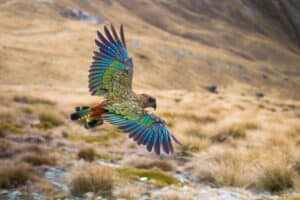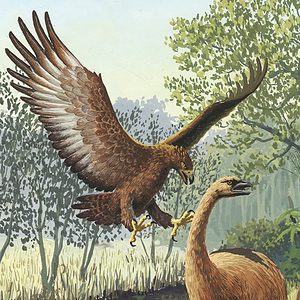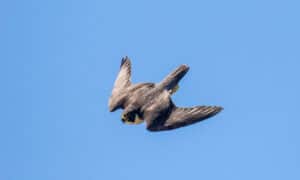Birds in California come in all shapes, sizes, and colors. Some live in forests and mountains, while others inhabit beaches and deserts. The ecosystem along with the plant and animal life is among some of the most diverse in the country. Discover all types of birds in California, including black, brown, blue, red, yellow, and green.
Black Birds in California
Tricolored Blackbird
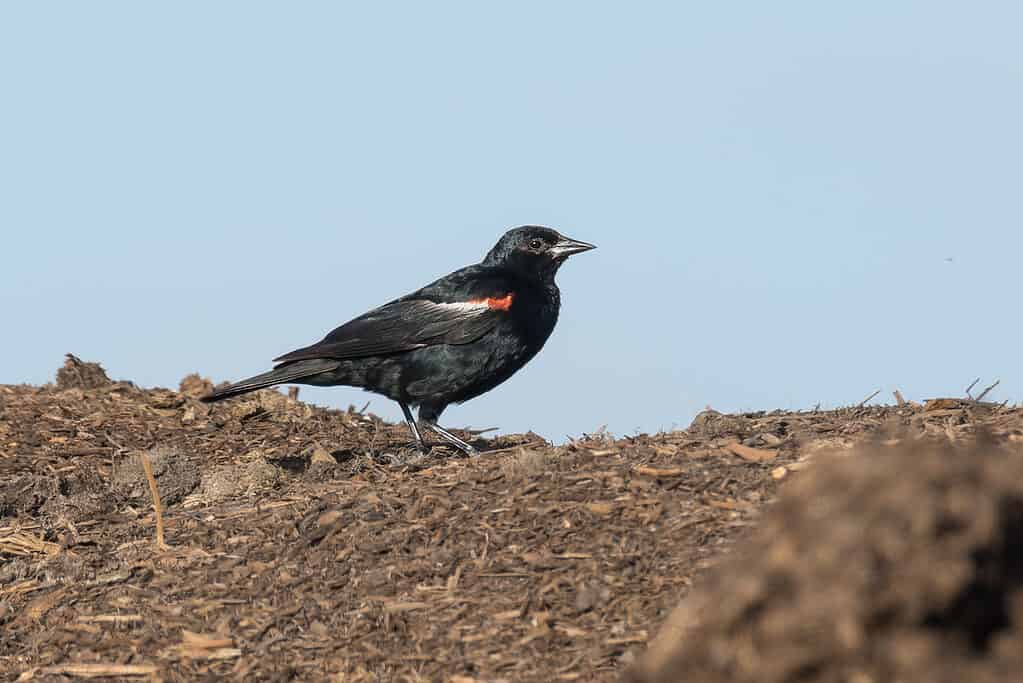
Tricolored blackbirds live in California’s central valley year-round, where they inhabit fields, roadsides, and wildlife areas.
©iStock.com/Wichyanan Limparungpatthanakij
Habitat and Range: Tricolored blackbirds are rare and have a very limited range. You can find them in California’s central valley, where they live year-round. They live in agricultural fields, along roadsides, and in natural wildlife areas.
Appearance: These stocky blackbirds are broad-shouldered and slightly hunchbacked. They have all-black plumage with bright red and white shoulder patches.
Diet: Insects and seeds
Vocalizations: Muffled and buzzy songs
Nests: A bulky open cup attached to standing vegetation
Great-Tailed Grackle
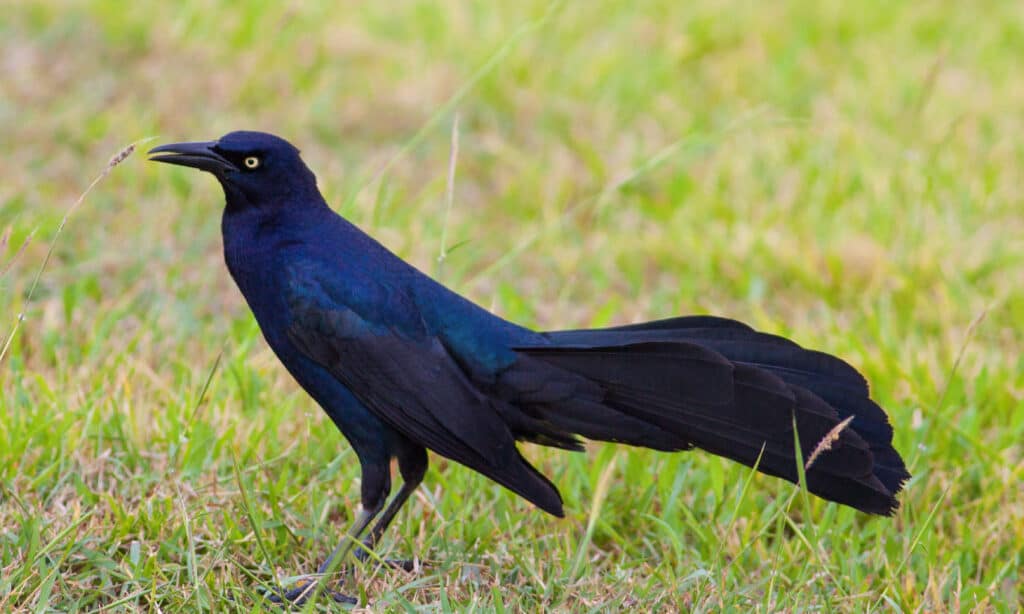
Great-tailed grackles live in Southern California in towns, parks, farms, and thickets.
©Melinda Fawver/Shutterstock.com
Habitat and Range: The great-tailed grackle lives in Southern California, especially in the southeast corner near the Arizona and Nevada borders. You can find this species in towns, parks, farms, and thickets.
Appearance: These slender birds are most notable for their long V-shaped tails and iridescent black plumage with bright yellow eyes.
Diet: Insects, small fish, reptiles, eggs, birds, seeds, berries, fruits, and nuts
Vocalizations: Whistles, clucks, and whistles
Nests: Bulky open twigs and grass cups in dense vegetation near water
Blue Birds in California
California Scrub Jay
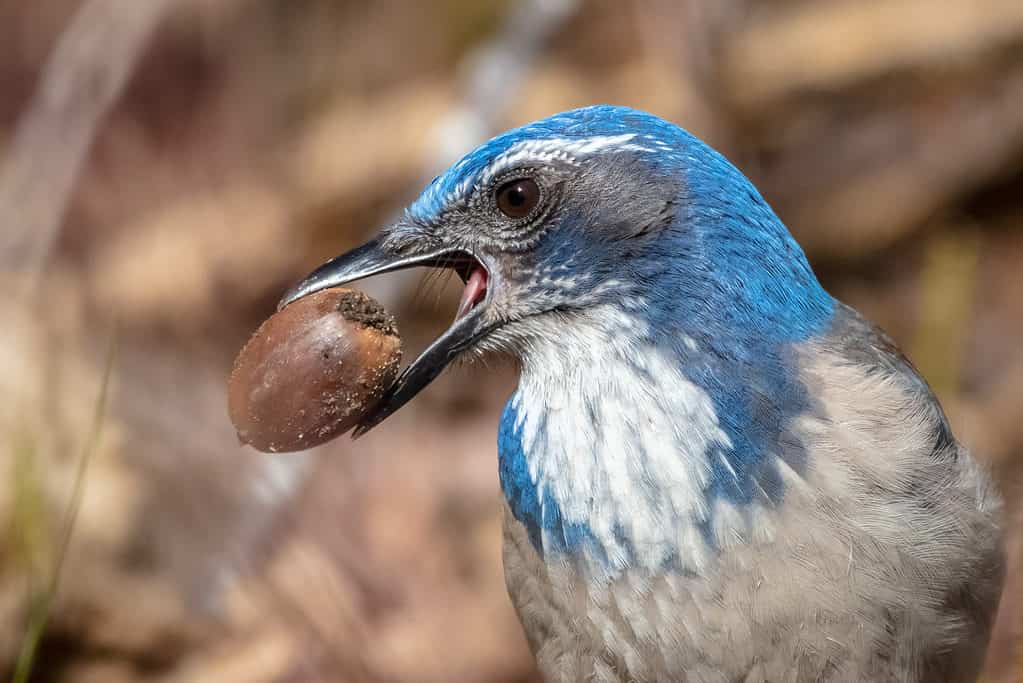
California scrub jays closely resemble blue jays. They are large and lanky with azure blue and gray plumage.
©Pierre Leclerc/Shutterstock.com
Habitat and Range: The California scrub-jay is a common sight along the Pacific Coast. You can find them throughout most of the state in woodlands, scrub, foothill forests, suburbs, and parks.
Appearance: They are fairly large and lanky songbirds with long tails and stout bills. Their plumage is azure blue and gray with grayish-white undersides.
Diet: insects, spiders, rodents, eggs, and small reptiles
Vocalizations: Soft, sweet medleys
Nests: Well-built twig cups in shrubs or trees
Pinyon Jay
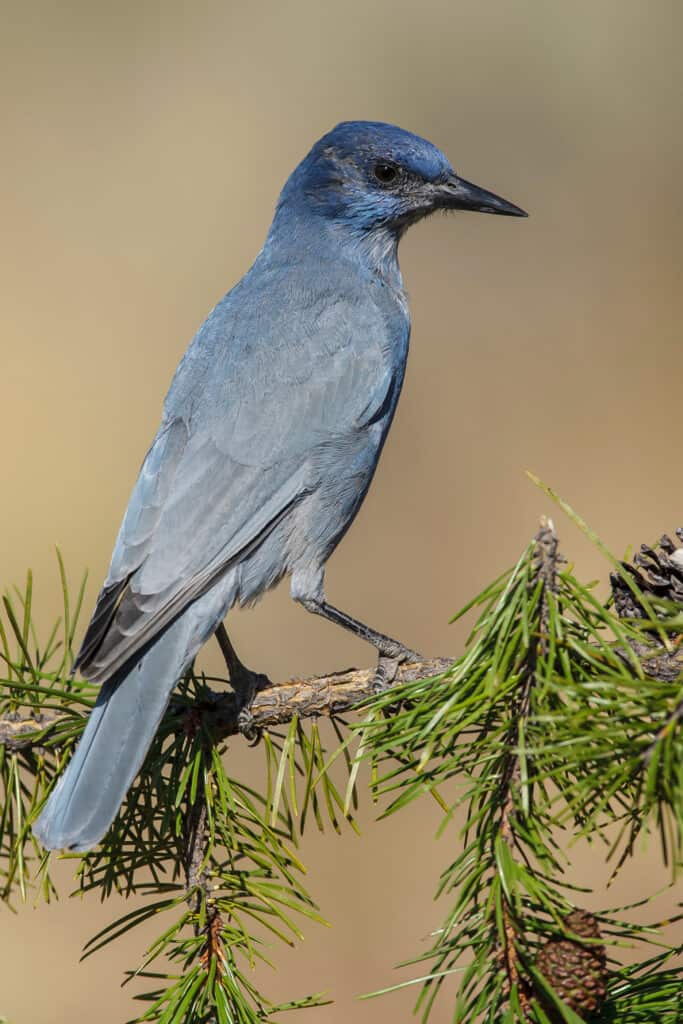
Pinyon jays live in pinyon pines, juniper, and scrub-oak woodlands in Eastern California year-round.
©Agami Photo Agency/Shutterstock.com
Habitat and Range: Pinyon jays live in the far eastern part of California year-round, where they inhabit pinyon pines, juniper, scrub-oak woodlands, and chaparral.
Appearance: These crestless jays are small and feature long, pointed bills and short tails. They are dusky blue with paler undersides and darker heads.
Diet: Pinyon pine seeds, other plants, berries, fruits, nuts, and insects
Vocalizations: Harsh nasal calls
Nests: A twig foundation with an inner cup made of shredded bark
Brown Birds in California
California Towhee
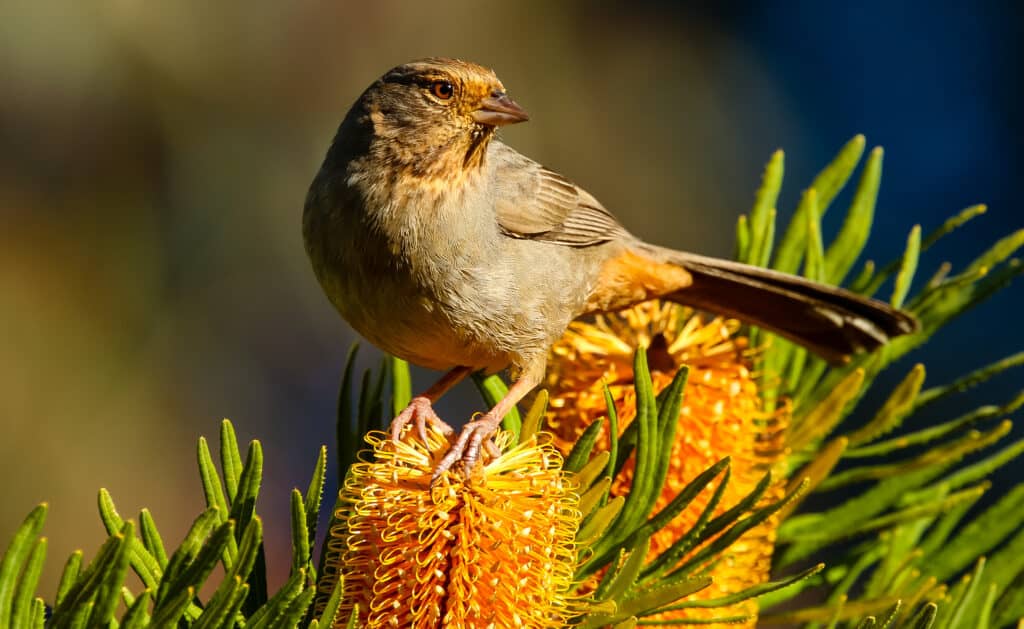
Towhees inhabit various ecosystems like woodlands, forests, and urban cities. The California towhee lives permanently along the Pacific seaboard.
©Benjamin Jacobs-Schwartz/Shutterstock.com
Habitat and Range: The California towhee lives permanently along the Pacific seaboard, where they are locally abundant in California. You can find them in brushy areas, coastal scrub, gardens, and city parks.
Appearance: They are large sparrows with long tails and thick bills. Their plumage is matte brown, except for rusty red patches around their beaks and under their tails.
Diet: Seeds and insects
Vocalizations: Squeaky, rapid chips
Nests: A loose, bulky twig cup placed in dense shrubs
Bewick’s Wren
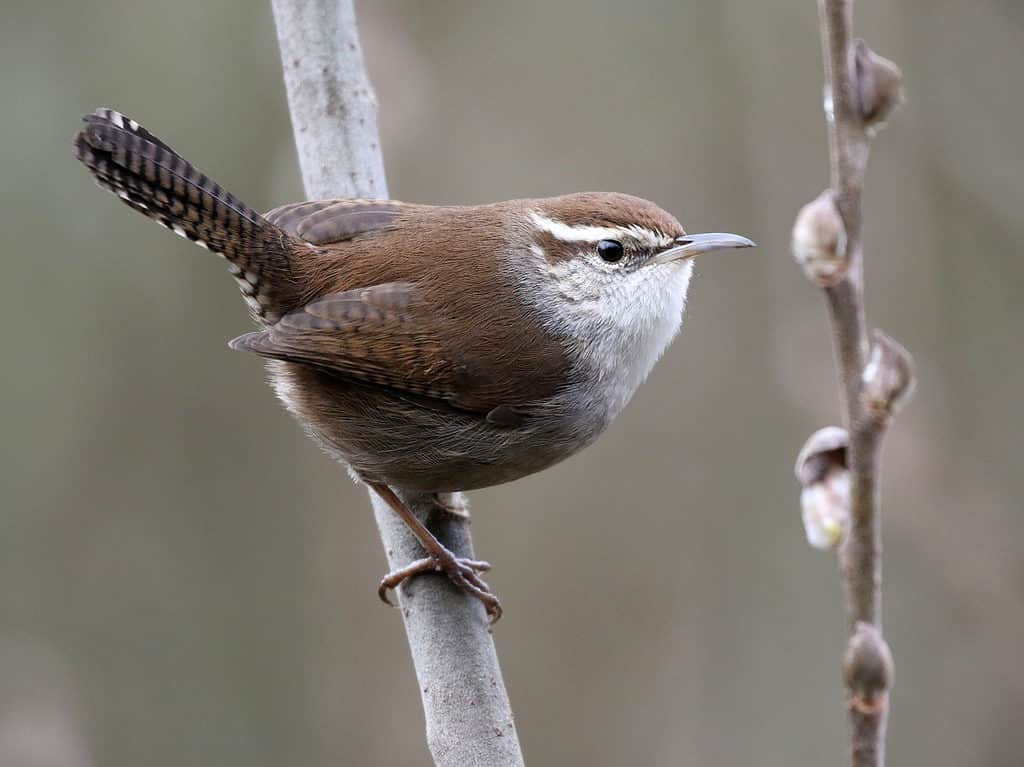
The Bewick’s wren lives in Northern California in brushy and scrubby habitats.
©iStock.com/randimal
Habitat and Range: The Bewick’s wren is a bird in Northern California, where they live year-round. You can also find them further south, but not as abundant. They like brushy and scrubby habitats.
Appearance: These medium-sized wrens have long tails and slightly curbed beaks. They have brownish-gray plumage with barred tails and bold white eyebrows.
Diet: Insects, spiders, berries, and seeds
Vocalizations: Loud, bubbly melodies
Nests: A twig and leaf foundation with a soft moss and animal hair cup
Yellow Birds in California
Wilson’s Warbler

Wilson’s warbler is one of the smallest warbler species and migrates through the state during spring migration.
©iStock.com/Leon Gin
Habitat and Range: The best time to see Wilson’s warbler is during spring migration as they make their way through the state. However, some populations stay during the breeding season in Northern California.
Appearance: They are one of the smallest warbler species and feature thin bills and long tails. They are olive-yellow above and bright yellow below and their heads have distinct black caps and beady black eyes.
Diet: Insects, spiders, and berries
Vocalizations: Rapid, staccato calls
Nests: An open cup made of dead grass and placed on the ground
Hooded Oriole
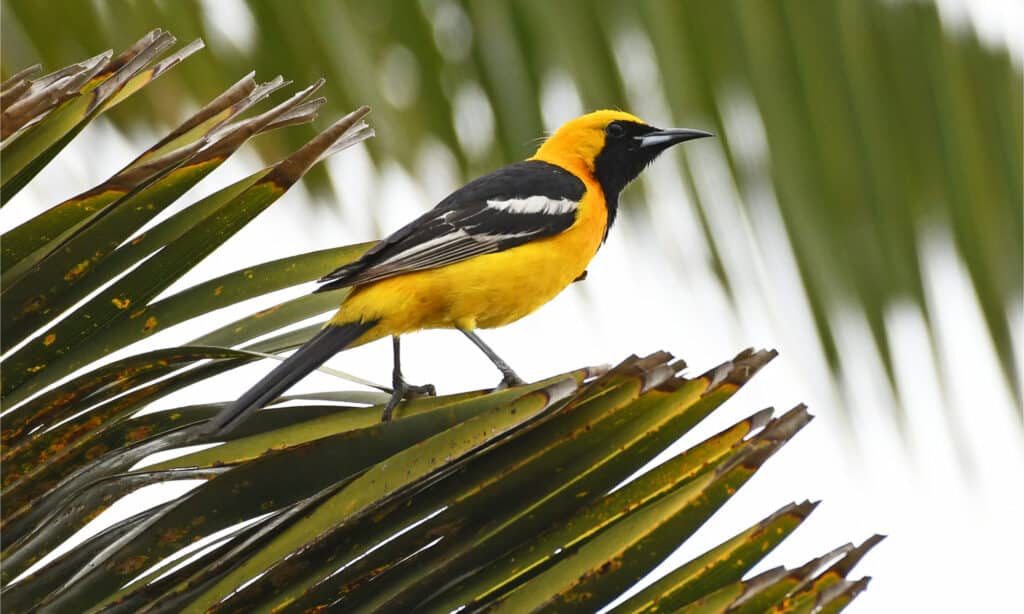
Hooded orioles prefer to nest in palm trees when they are available. They live in scorching lowlands in Southern California.
©A. Viduetsky/Shutterstock.com
Habitat and Range: The hooded oriole inhabits scorching lowlands in Southern California during the breeding season. Look for them in tree groves near streams and canyons.
Appearance: Their bodies are long and slender and feature black, yellow, flame orange, and white plumage.
Diet: Insects, berries, and nectar
Vocalizations: Whistles and chatters
Nests: A woven plant fiber pouch hanging from a palm or yucca
Green Birds in California
Violet-Green Swallow
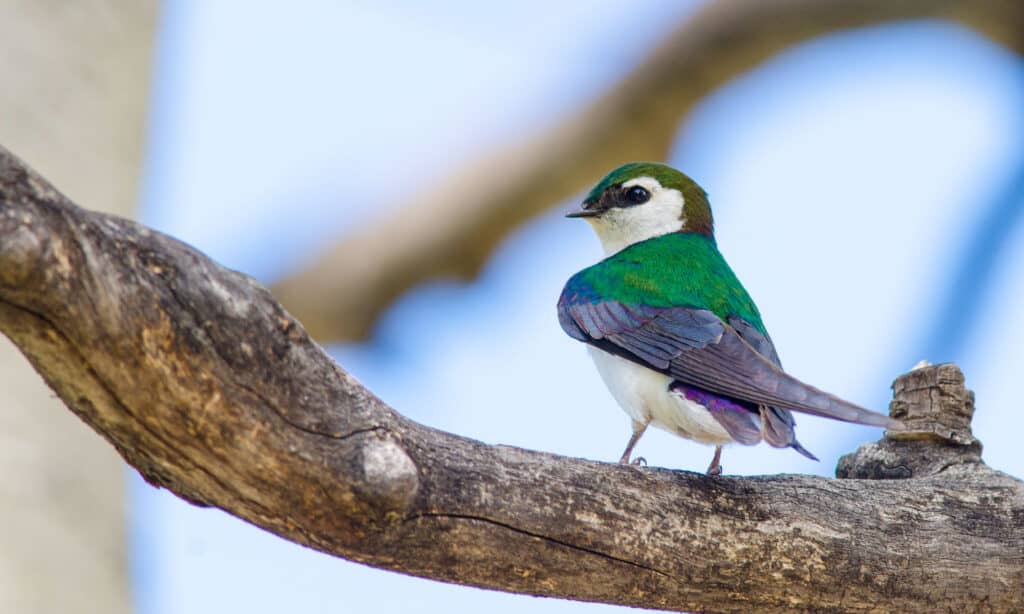
The violet-green swallow breeds throughout California. You can find them in mountains, forests, and towns.
©iStock.com/spates
Habitat and Range: Violet-green swallows spend their springs and summers throughout California. You can find their nests in many habitats, such as mountains, forests, and towns.
Appearance: These sleek swallows have long, pointed wings and forked tails. Their plumage is iridescent green-bronze, violet, and gray above and white below.
Diet: Insects
Vocalizations: Simple chirps
Nests: Grass cups in a cavity (rock crevice, woodpecker hole, etc.)
Hutton’s Vireo
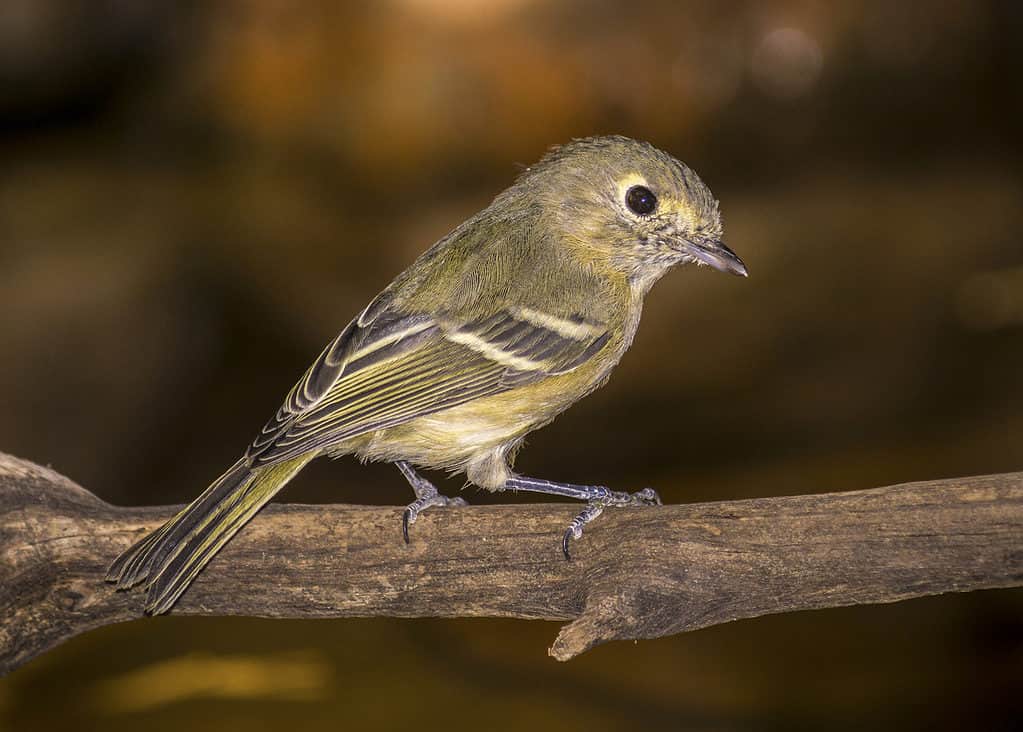
Hutton’s vireo is a permanent resident of California coast in woods and shrubby understory.
©iStock.com/MBRubin
Habitat and Range: The Hutton’s vireo is a songbird of the Pacific Coast. They live permanently along California’s coast in woods and shrubby understory.
Appearance: Small and plump, these songbirds have thick necks and short wings. Their plumage is olive-gray above and pale gray below.
Diet: Insects, berries, and small fruits
Vocalizations: Loud whistles and chatters
Nests: A round cup covered in plant down and spider egg cases
Tiny birds in California
Ruby-Crowned Kinglet
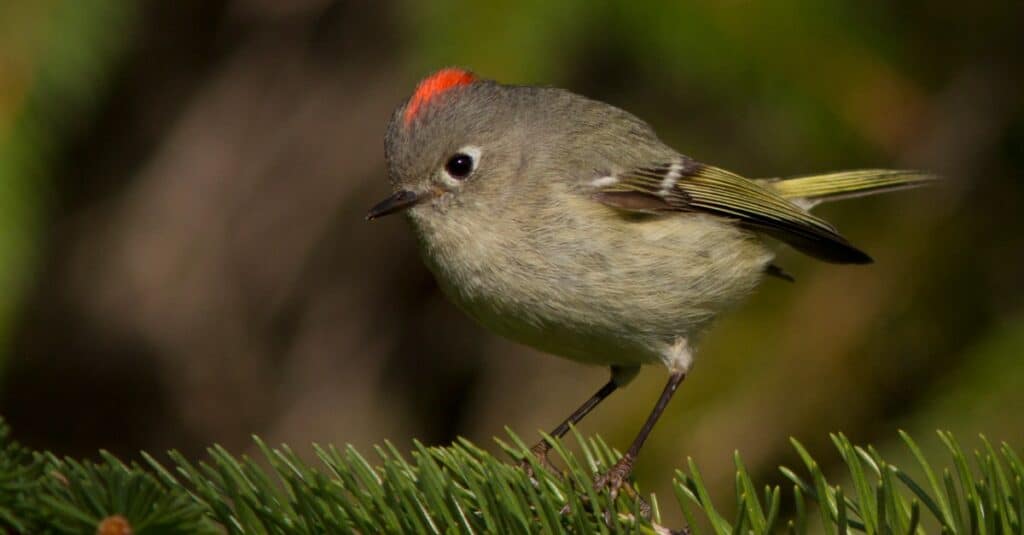
The Ruby-Crowned Kinglet averages around four inches in length. They have short bills and short tails.
©iStock.com/mirceax
Habitat and Range: Ruby-crowned kinglets breed in Northeastern California and winter across the rest of the state. These birds breed in coniferous forests and winter in many wooded and brush habitats.
Appearance: This tiny songbird has a short bill and short tail. They are olive green with white eyering and a shaggy ruby red crown.
Diet: Insects, berries, and seeds
Vocalizations: Excited melodious chatters
Nests: A deep hanging moss and lichen cup
Calliope Hummingbird
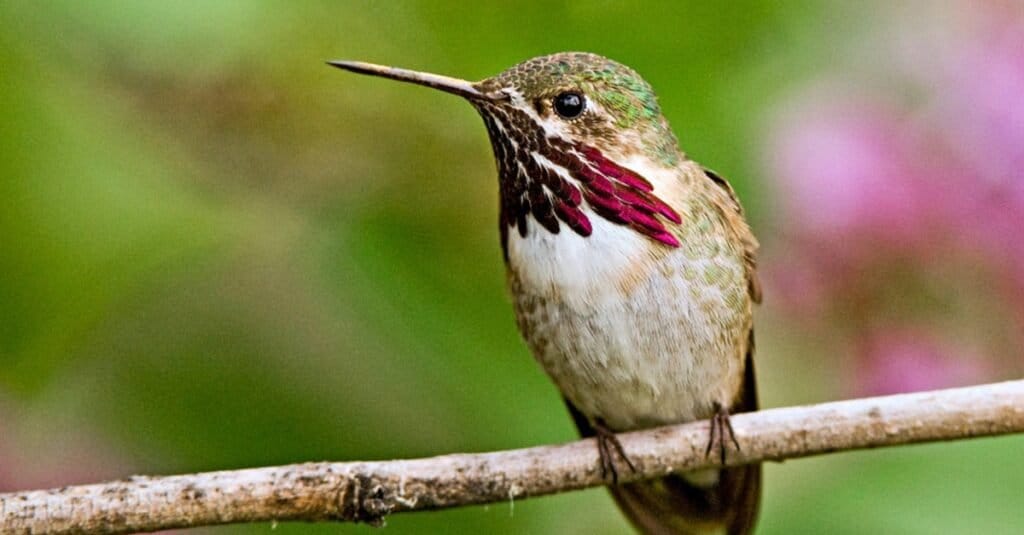
The Calliope Hummingbird is the smallest bird native to the United States and Canada. It has a western breeding range mainly from California to British Columbia.
©MTKhaled mahmud/Shutterstock.com
Habitat and Range: The Calliope hummingbird is another breeding bird of Northeastern California. They prefer open shrubby areas near streams; look for them perched on a bare branch sticking out.
Appearance: They are small for hummingbirds, measuring around three inches and weighing 0.1 ounces. They are green above and white below with shiny magenta throats.
Diet: Nectar and insects
Vocalizations: High-pitched zings
Nests: A compact plant-down cup in pine or conifer
Big Birds in California
California Condor
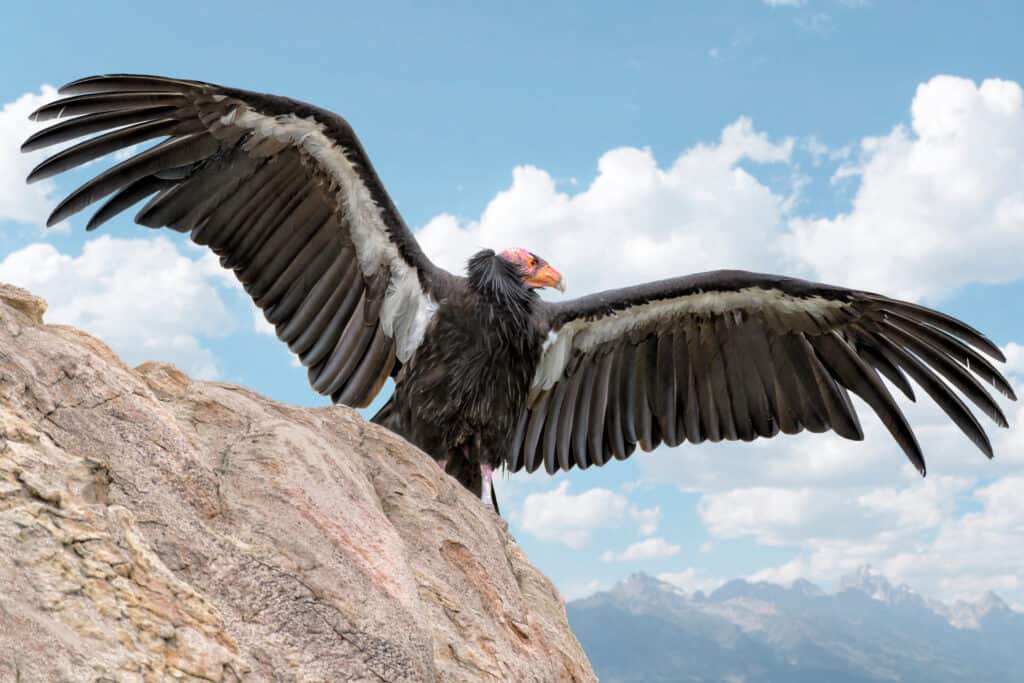
California condors have a 9-foot wingspan. They are the largest birds in North America.
©Barbara Ash/Shutterstock.com
Habitat and Range: California condors are permanent residents of Central and Southern California. They live in remote areas, like rugged mountainous terrain, steep cliffs, and grasslands.
Appearance: They are the largest birds in North America and feature exceptionally long, broad wings, measuring nine feet long! They are black with white patches under their wings and yellow-orange heads and necks.
Diet: Carrion
Vocalizations: Typically silent
Nests: They nest on stones and gravel in caves or rock crevices.
Great Gray Owl
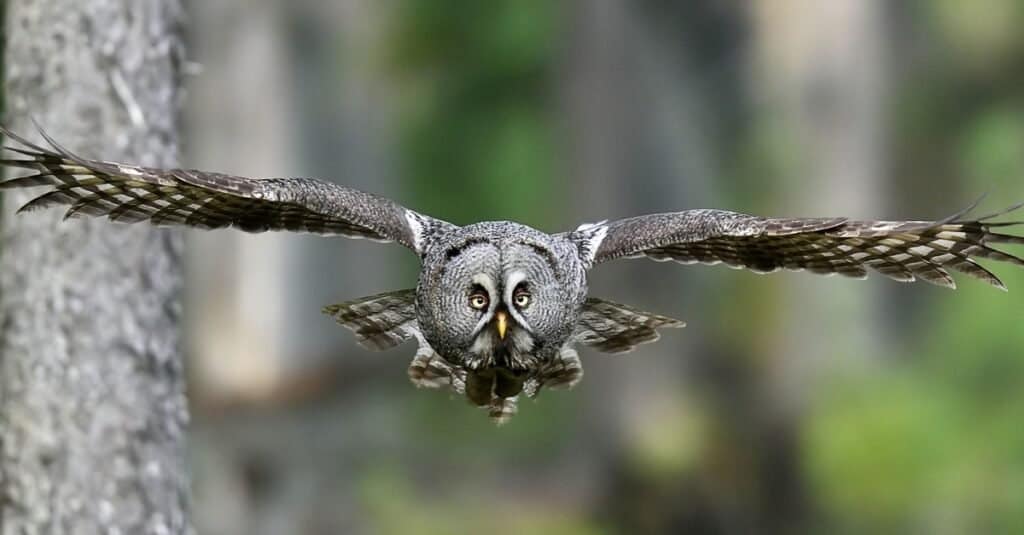
A great grey owl in flight. These silver animals are considered Endangered in California due to habitat loss.
©Erik Mandre/Shutterstock.com
Habitat and Range: The great gray owl lives year-round in Northeastern California in dense conifer forests. They use open habitats for hunting, such as meadows and clearings.
Appearance: It is one of the tallest owls in North America, featuring broad wings and long tails. Their plumage is silvery gray and heavily streaked and their eyes are bright yellow.
Diet: Small mammals, rodents, and small birds
Vocalizations: Deep, booming “whoo”
Nests: Abandoned bird nests
Common Birds of Southern California
White-Crowned Sparrow
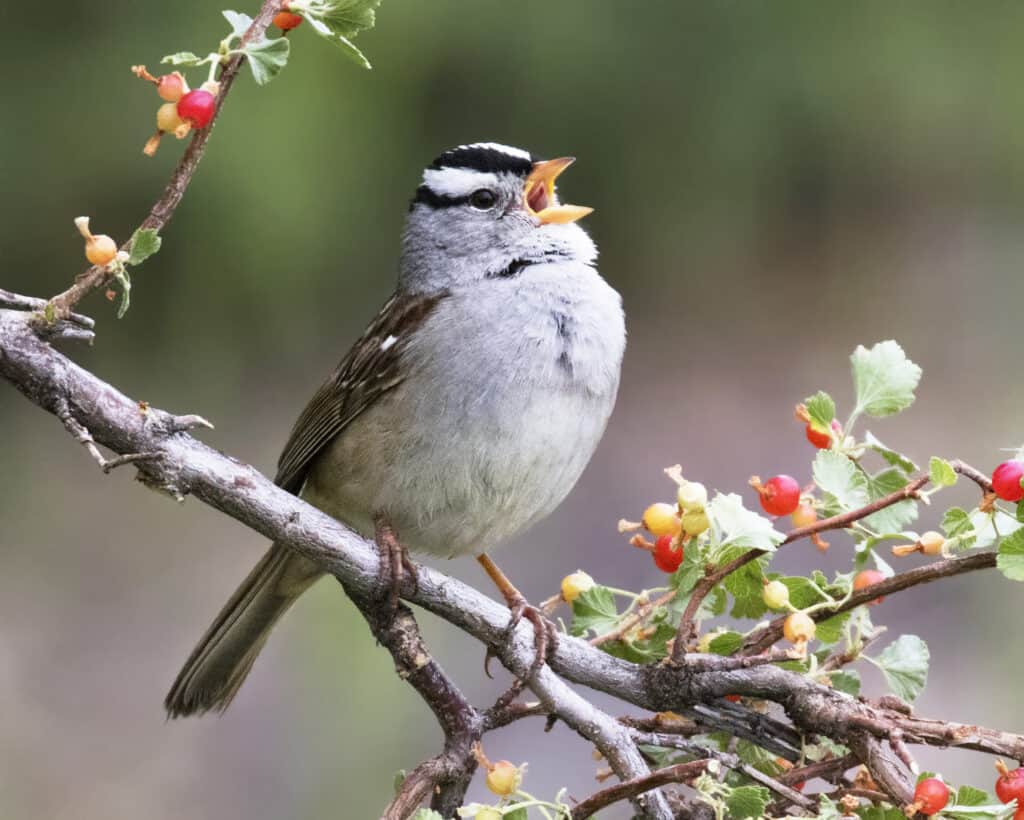
The white-crowned sparrow (Zonotrichia leucophrys) is a medium-sized New World sparrow native to North America.
©Rbrown10/Shutterstock.com
Habitat and Range: White-crowned sparrows spend their winters across California, with some populations along the coast staying year-round. They live in farms, desert washes, and overgrown fields.
Appearance: They are large sparrows with long tails and short bills. And they are streaky gray with black and white striped heads and orange beaks.
Diet: Seeds
Vocalizations: Short, clear whistles
Nests: Open grass cups in shrubs
Bullock’s Oriole
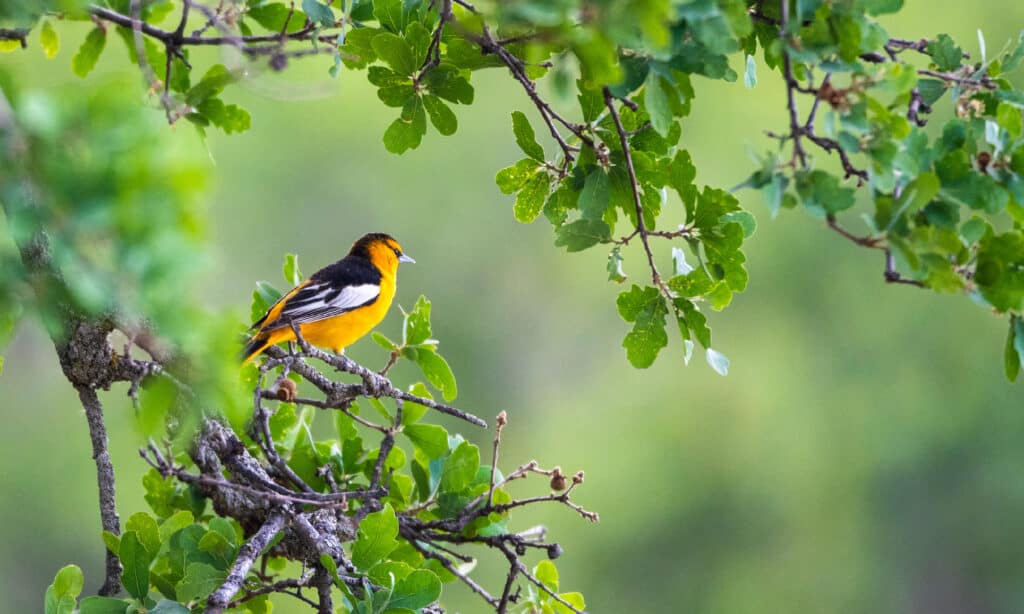
Bullock’s oriole is a breeding bird throughout California, inhabiting deciduous trees in open habitats.
©iStock.com/zhuclear
Habitat and Range: The Bullock’s oriole breeds throughout California in deciduous trees in open habitats, like forest edges, groves, and streamside woods.
Appearance: Slim and bulky, the Bullock’s oriole is black and bright orange with white wing patches.
Diet: Insects, berries, and nectar
Vocalizations: Flute-like whistles
Nests: Tightly woven plant fiber cups lined with plant down and fur
The photo featured at the top of this post is © iStock.com/Chelsea Sampson
Thank you for reading! Have some feedback for us? Contact the AZ Animals editorial team.



